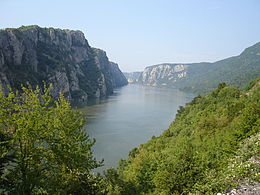This article includes a list of general references, but it lacks sufficient corresponding inline citations. (February 2011) |


The Iron Gates (Bulgarian: Железни врата; Romanian: Porțile de Fier; Serbian: Ђердапска клисура / Đerdapska klisura or Гвоздена капија / Gvozdena kapija; Hungarian: Vaskapu-szoros) is a gorge on the river Danube. It forms part of the boundary between Serbia (to the south) and Romania (north). In the broad sense it encompasses a route of 134 km (83 mi); in the narrow sense it only encompasses the last barrier on this route, just beyond the Romanian city of Orșova, that contains two hydroelectric dams, with two power stations, Iron Gate I Hydroelectric Power Station and Iron Gate II Hydroelectric Power Station.
At this point in the Danube, the river separates the southern Carpathian Mountains from the northwestern foothills of the Balkan Mountains. The Romanian side of the gorge constitutes the Iron Gates Natural Park, whereas the Serbian part constitutes the Đerdap National Park. A wider protected area on the Serbian side was declared the UNESCO global geopark in July 2020.[1][2]
Archaeologists have named the Iron Gates mesolithic culture, of the central Danube region circa 13,000 to 5,000 years ago, after the gorge. One of the most important archaeological sites in Serbia and Europe is Lepenski Vir, the oldest planned settlement in Europe, located on the banks of the Danube in the Iron Gate gorge.[3]
- ^ "UNESCO designates 15 new Geoparks in Asia, Europe, and Latin America". UNESCO. 2020-07-10. Retrieved 2020-07-13.
- ^ Dimitrije Bukvić (19 July 2020). "Đerdap – prvi srpski geopark" [Đerdap – first Serbian geopark]. Politika (in Serbian). p. 9.
- ^ Sormaz, Andela (5 May 2020). "Lepenski Vir". World History Encyclopedia. Retrieved 29 July 2020.
The overall architecture at Lepenski Vir is of a specific shape with all the houses built according to a plan.